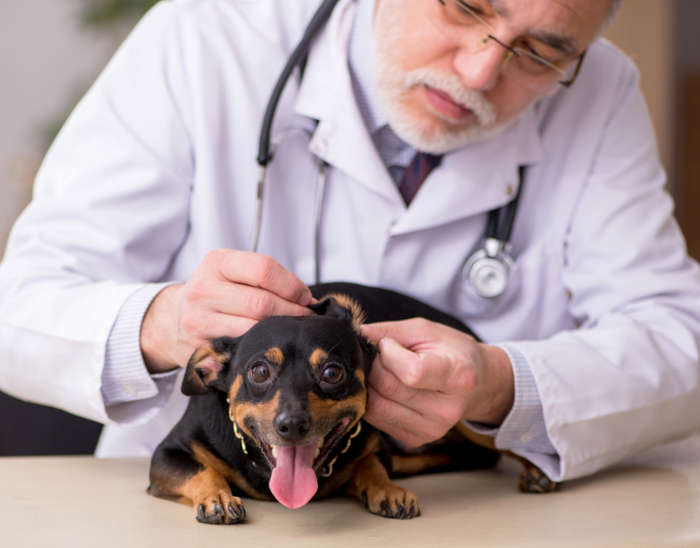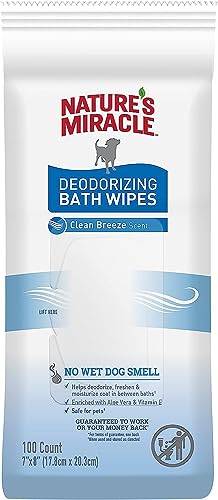
Yeast is a normal inhabitant of your dog’s skin. When all systems are healthy, you won’t even know it’s there. But when something gets off with your dog’s normal balance, those yeast numbers can really bloom, creating a yeasty smell and possibly other signs. Here’s what you need to know:
Overview of yeast smell in dogs: what does it smell like?
Frito Feet, stinky ears, and the “doggy smell” might be characteristic odors for many dog owners. Sometimes the smell gets overwhelming or appears on a dog you’ve never noticed it on before. Yeast smell in dogs is often recognized as a musty, cheesy odor and can be quite distinct. While it’s natural for dogs to have a smell of their own, a strong and persistent yeast odor may indicate an underlying issue that needs attention.
How do you know if your dog has a yeast infection?
Some dogs naturally have a very mild yeasty odor. Others will only have it when they have an infection going on. Other signs of a skin yeast infection include:
- Skin redness or thickening
- Itchiness or discomfort/ pain
- Unusual discharge, a build up of unpleasant looking or smelling material, especially in skin creases or skin folds
- For yeast infections i
Causes of yeast smell in dogs
While some degree of doggy odor is normal, any change or increase in odor may indicate that something’s wrong and treatment is needed:
- Normal body odor: Dogs have a smorgasbord of normal, healthy bacteria, yeast, and other organisms. So a mild odor that isn’t paired with other signs of illness might just be a dog’s normal smell.
- Yeast overgrowth in the skin: While some amount of yeast on the skin is normal, an overgrowth of yeast is recognizable by greasy or flaky skin, itchiness, and redness. All of this will be accompanied by a stronger-than-usual odor that you may smell even from a distance.
- Ear infections: A yeasty smell coming from the ears, though, is not normal and should be treated professionally before it gets advanced. Foul-smelling ears, head shaking and scratching, and ear discharge may suggest an ear infection. Leaving an ear infection untreated could allow it to be severe enough to cause hearing loss. A veterinarian should always be consulted because of the risk of damaging the ears.
- Environmental factors: Allergies or poor hygiene can contribute to a yeast smell. Skin that is constantly sensitive and inflamed from allergies is more prone to overgrowth of smelly organisms. Dogs that are frequently wet or dirty and aren’t well cleaned after a messy event may end up with bacterial or yeast overgrowth in areas that don’t then get groomed by the dog as a normal practice. Addressing the root cause is important.
Can yeast dog smell be a sign of an underlying health issue?

Chronic yeast smell, or the sudden appearance of a yeasty odor in a dog who has never had it before, may indicate an underlying health problem. This may include allergies, hormonal imbalances, immune system issues, or an underlying disease that’s leaving them prone to infection or causing bodily imbalances.
What owners can do at home:
When it comes to ear infections, treatment at home shouldn’t be considered. However, a mild or moderate yeasty smell in a dog who is otherwise happy, healthy, and comfortable might be manageable at home:
- Spot-clean any affected areas with a pet-safe product meant for gentle cleansing
- EASY-TO-USE WIPES: Deodorizing bath wipes helps neutralize tough pet odors in between baths.
- Bathe your dog as needed using a gentle, skin-friendly shampoo
- DID YOU KNOW DOG SKIN DIFFERS FROM HUMAN'S - Dogs' skin is less acidic than human skin, so human shampoos destroy a dog's skin protective barrier, leaving your pet vulnerable to itchy flaking
- Don’t bathe your dog too often (see below) or you may put them at greater risk for skin infections
- Maintain proper hygiene and grooming practices, such as keeping long fur trimmed, and brushing dogs regularly
- Dual Level Pin Design – Safely aids in removal of mid to top level fur & hair as well as gently removing lower lever fur while protecting your pets’ delicate skin; large head size allows you to cover large sections of hair
- Consider OTC or veterinary probiotic products meant for dogs, which can help balance overall health and amounts of healthy bacteria
- TASTES LIKE A TREAT – Probiotic Everyday is a deliciously healthy way to support your dogs upset stomach, gassiness, diarrhea, constipation and food intolerances. These soft chews have a yummy duck flavor that dogs crave
View our recommendations for the best probiotics for dog yeast infections.
Bathing dogs to prevent or manage yeasty smells: how often should I do it?
Because of the wide variety of dog breeds and mixes, coat types, animal sizes, and health histories, it’s impossible to pinpoint one solid guideline for any individual dog. In general, you can stick close to these timelines when making a plan to bathe your dog:
- Regular Dogs: For most dogs with a healthy coat and skin, bathing once every 2 to 3 months is typically sufficient. Regular brushing and grooming can help keep their coat clean and free of debris in between baths.
- Short-Coated Dogs: Breeds with short hair or coats, such as Beagles or Boxers, usually require less frequent bathing, about every 3 to 4 months. They can still benefit from gentle brushing occasionally.
- Long-Coated Dogs: Dogs with longer hair, like Shih Tzus or Golden Retrievers, may benefit from more frequent bathing, approximately every 6 to 8 weeks. They should be regularly brushed between bathings, and extra care should be taken if they get dirty or wet.
- Active Dogs: If your dog is very active, enjoys outdoor adventures, or gets dirty frequently, you may need to bathe them more often. In this case, bathe as often as needed to keep their coat clean but consider water rinses and conditioner, instead of regularly shampooing, which might dry their skin out. Dry shampoos may be an option as well.
Frequent unnecessary bathing can damage the integrity of healthy skin, making over-bathed dogs more prone to skin infections including yeast. If your dog gets dirty between normal baths, you can spot-rinse with water or use a little dry shampoo. Be sure to get your dog completely dry after a bath or any other time they get wet. Having moisture against the skin can lead to irritation, hot spots, and yeast overgrowth as well.
When to visit the vet for a yeasty dog smell
Contact the vet if:
- Home remedies don’t improve the smell after a few days.
- Your dog shows signs of discomfort or pain.
- The odor is accompanied by other concerning symptoms.
When my pet goes to the vet for a yeast infection, what can I expect?
At a vet visit for yeasty smells, you can expect:
- Veterinary examination: Costing $50-$100 on average, an exam is the first step in determining the cause and appropriate treatment for the issue.
- Tests for underlying conditions: While treatment may be straightforward in some cases, a more severe issue or a persistent one that isn’t resolving might require testing. Sometimes it’s a gentle surface-swab of the skin to see what bacteria or other organisms are present. This might cost up to $100. In some cases, more advanced testing is needed including allergy panels or skin culture, and these may cost a couple hundred dollars or more.
- Medication for yeast infections: The treatments for yeast infections can vary depending on cause, severity, and individual veterinarian preference based on their experience. A simple topical treatment might be less than $50, though in some cases a regimen of products may be recommended. This often includes topical sprays or ointments in combination with specialized shampoo/ conditioner products, and can cost upwards of $100. If treatment for more severe infections with secondary issues like damaged skin is necessary, additional medications to keep your dog comfortable will be prescribed alongside the topical medications and bathing products.
- Treating underlying conditions: Dogs that have underlying immune system disorders or other chronic diseases may require additional treatments, including changes in diet and other medications. This may cost $20-$100 per month and may be lifelong.
Frequently Asked Questions
Can I use human antifungal creams on my dog?
Without explicit veterinary instruction, it’s not safe to use human antifungal creams on dogs. Many human healthcare products are hazardous or even deadly for use in dogs, and even using a pet-safe human healthcare product incorrectly can spell disaster. Consult with your dog’s veterinarian before trying to use any human or dog antifungal creams, or learn more about fungal skin infections in dogs.
Can I bathe my dog to combat yeast smell?
Bathing can help clean soiled skin, remove shed fur, and maybe even rebalance skin bacteria, all of which can help manage the risk for a yeast infection. But be sure to choose a well rated pet-safe product meant for sensitive skin. Do not use flea/tick shampoos or sprays, medicated shampoos, or products meant for humans.
Bathing too frequently can put your dog at risk for further skin issues, so avoid bathing any more often than every 6 – 8 weeks (less often for dogs with short coats) or unless visibly soiled.
Are there any dietary changes I should make to address yeast issues?
Consult your dog’s veterinarian before making any diet changes. Food allergies in dogs are less common, but the signs are much more obvious, than many people believe. Changing a diet rapidly or frequently can cause more harm than good.
How long does it take to eliminate the yeast smell in dogs?
The timeline for getting rid of a yeasty smell varies based on the underlying cause and the chosen treatment plan. Improvement may be seen in a few days to weeks if successfully managed by your dog’s veterinarian, but it may take longer if you try to manage it at home and aren’t addressing the underlying cause.
It’s also possible that your dog’s personal balance of bacterial/ yeast on the skin is just one that promotes slight overgrowth of yeast. Many dogs live their entire lives with “frito feet” without experiencing any health difficulties because of it.
Are certain dog breeds more prone to yeast overgrowth?
Some breeds are predisposed to skin issues that can lead to yeast overgrowth. These may include:
- Bulldogs
- Basset Hounds
- Cocker Spaniels
Disclaimer: This website's content is not a substitute for veterinary care. Always consult with your veterinarian for healthcare decisions. Read More.







Be the first to comment